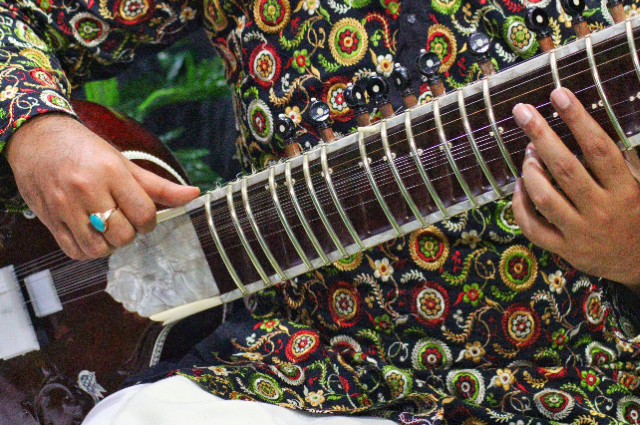
Photo by Saubhagya gandharv on Unsplash
Researchers at the University of California, Santa Barbara have made a remarkable discovery that fundamentally challenges our understanding of how ancient cultures spread across continents. Through meticulous analysis of musical patterns, they have uncovered compelling evidence that Vedic cultural influence extended far beyond the Indian subcontinent over three millennia ago.
The breakthrough comes from Dr. Dan C. Baciu's comprehensive study, published on Preprints.org, which employed cutting-edge computer-assisted analysis to compare ancient musical compositions from vastly different geographical regions. This research methodology represents a new frontier in archaeological and cultural studies, demonstrating how technology can reveal connections that traditional historical analysis might miss.
Mediterranean-Vedic Connection: Analyzing the Hymn to Nikkal
The centerpiece of this research focuses on the "Hymn to Nikkal," an ancient composition created over 3,000 years ago along the eastern Mediterranean coast in the ancient city of Ugarit. When Dr. Baciu subjected this hymn to detailed rhythmic analysis and compared it with verses from the Rig Veda, the results were nothing short of extraordinary.
The statistical evidence is particularly compelling as approximately one in every five verses from the Rig Veda concludes with identical cadential patterns found in the Hymn to Nikkal. The probability of such similarities occurring by mere coincidence is less than one in a million, suggesting a deliberate cultural transmission rather than random parallel development.
The research reveals that both ancient compositions employ a sophisticated dual-cadence system. The Mediterranean hymn incorporates two distinct types of rhythmic conclusions than a straightforward simple cadence and a more complex pattern. This same organizational structure appears in the Rig Veda, where the simple cadence typically marks verse endings while the complex pattern aligns with the traditional Triṣṭubh meter which is a specific Sanskrit poetic meter consisting of eleven syllables per quarter-verse.
This parallel structural organization suggests not merely coincidental similarity but indicates a shared musical and poetic tradition that transcended geographical boundaries in the ancient world.
Musical Patterns as Cultural DNA : Pitch Relationships and Melodic Contours
Beyond rhythmic similarities, the research delves into the melodic characteristics of both compositions. The pitch relationships are that the way musical notes ascend and descend throughout the compositions demonstrate remarkably consistent patterns between the Hymn to Nikkal and Rig Vedic verses. These melodic contours, which Indian scholars have long recognized as distinctive features of Vedic chanting, appear with striking consistency in the Mediterranean composition.
Digital Reconstruction and Auditory Evidence
The study's methodology included sophisticated digital reconstruction of these ancient melodies by allowing researchers to both visualize and audibly experience the similarities. This technological approach provides unprecedented insight into how these compositions would have sounded to ancient audiences, revealing melodic parallels that span continents and cultures.
The digital recreations demonstrate that despite originating from different civilizations separated by thousands of miles, these compositions share melodic DNA that suggests common cultural ancestry or significant cross-cultural exchange.
Persistence of Musical Traditions Through Time
One of the most fascinating aspects of this discovery is how musical traditions survived the collapse of the civilizations that created them. While ancient kingdoms like Ugarit vanished from history, their musical legacy continued through generations, preserved in oral traditions and cultural practices that transcended political boundaries.
The research suggests that the Mitanni kingdom served as a crucial cultural bridge, facilitating the exchange of Vedic traditions and musical practices between the Indian subcontinent and Mediterranean regions. This kingdom's strategic position enabled the flow of cultural elements across vast distances, creating a network of shared artistic expression that predates many known historical connections.
Echoes Through the Centuries: From Ancient Hymns to European Poetry
Perhaps most remarkably, Dr. Baciu's research traces these same musical patterns through subsequent centuries and cultures. The study identifies similar rhythmic and melodic structures in Greek lyric poetry, particularly in the works of Sappho, demonstrating the continued influence of these ancient musical traditions in classical Mediterranean literature.
Even more surprising is the discovery of these patterns in much later European works, including the poetry of German writer Friedrich Hölderlin in 1801. This suggests that these ancient musical structures possessed such fundamental appeal and effectiveness that they continued to influence artistic expression across millennia and cultural transformations.
Implications for Understanding Ancient Globalization
Dr. Baciu's research leads to the conclusion that music may have served as humanity's first truly global language. This hypothesis suggests that musical patterns and structures provided a universal medium for cultural exchange long before written languages or formal diplomatic relations established connections between distant civilizations.
This finding challenges traditional historical narratives that emphasize the isolation of ancient cultures. Instead, it presents evidence for a more interconnected ancient world where artistic and spiritual traditions flowed freely across geographical and cultural boundaries, creating shared human experiences that exceeded local differences.
Redefining Cultural Boundaries in Ancient History
The implications of this research extend far beyond musicology or archaeology. These findings suggest that our understanding of ancient cultural boundaries may be far too rigid. Rather than viewing ancient civilizations as isolated entities, this evidence points toward a more fluid, interconnected world where ideas, traditions, and artistic expressions moved freely across vast distances.
This groundbreaking research opens new avenues for understanding how ancient cultures interacted and influenced one another. By using musical analysis as an archaeological tool, researchers have revealed connections that traditional historical methods might never have uncovered. The discovery that Vedic cultural influence extended to the Mediterranean over 3,000 years ago fundamentally reshapes our understanding of ancient globalisation and cultural exchange.
As we continue to develop new technological approaches to studying the past, we may discover that our ancestors were far more connected than we ever imagined. Music, as this research demonstrates, may indeed have been the thread that wove together the tapestry of human civilization by creating shared experiences that unite us across time, geography, and culture.
. . .
References:
